8 E-Procurement Statistics You Need to Know


Are you looking to find out more about the state of e-procurement?
You’re in the right place.
In this article, we present eight compelling statistics that illustrate just that.
Its benefits, perceived value among companies of different sizes, real-life applications, impact on businesses as a whole, and more—we cover it all.
This interesting read won’t just make you better-informed about e-procurement, but will also show you how it can revolutionize procurement processes within your own company.
So, let’s get started!
Provided by Statista, this statistic shows that sales through e-procurement platforms worldwide have experienced steady growth since 2019, surpassing a remarkable 1 trillion USD in 2022.
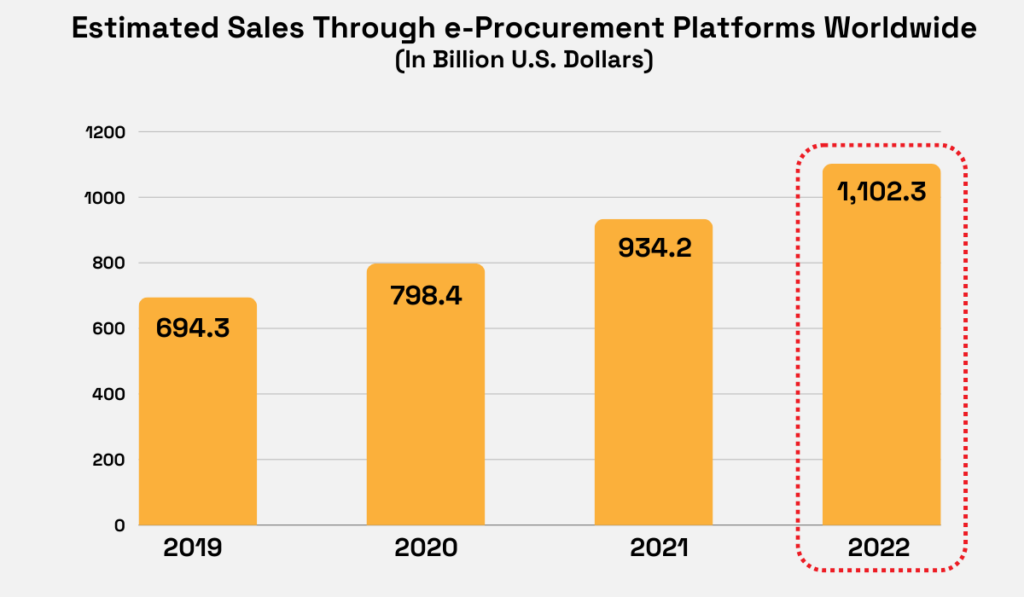
Illustration: Veridion / Data: Statista
This indicates a significant shift towards the adoption and reliance on digital platforms for procurement activities, leaving traditional methods behind.
But what makes e-procurement so different and appealing?
Well, traditional procurement is often bogged down by manual processes, endless paperwork, phone calls, and in-person meetings.
In contrast, e-procurement leverages technology to automate the buying process.
It allows procurement professionals to interact with suppliers online, send out requests for quotations (RFQs) and proposals (RFPs), receive bids, generate and process invoices, and more—all electronically.
This makes the entire process more transparent and streamlined, resulting in greater visibility, better supplier performance management, and more efficient operations in general.
Kristin Ruehle, Procurement Business Process Services Offering Lead at Accenture, an IT service company, delves a bit deeper into the benefits of this technology:
“For example, manual, routine processes are automated to improve user experience and reduce costs. Real-time insights help guide business stakeholders on day-to-day operations or buying agents on purchasing decisions. New levels of collaboration afforded by cloud-based multi-client platforms transform buyer interactions with suppliers and other third parties.”
Put simply, e-procurement takes the whole process to the next level, leading to considerable time and cost savings and overall better procurement outcomes.
So, it’s no wonder that, as shown by Statista, companies are increasingly relying on e-procurement platforms and recognizing the immense perks they offer.
The annual Global Chief Procurement Officer survey from Deloitte suggests that the potential of e-procurement tools was recognized as early as 2018.
Interestingly enough, this was well before the COVID-19 pandemic spurred the rapid adoption of such technologies.
Conducted with 504 procurement leaders from 39 countries, the survey revealed that nearly half (43%) of CPOs believed at the time that precisely this technology would have the most significant impact on the businesses down the line.
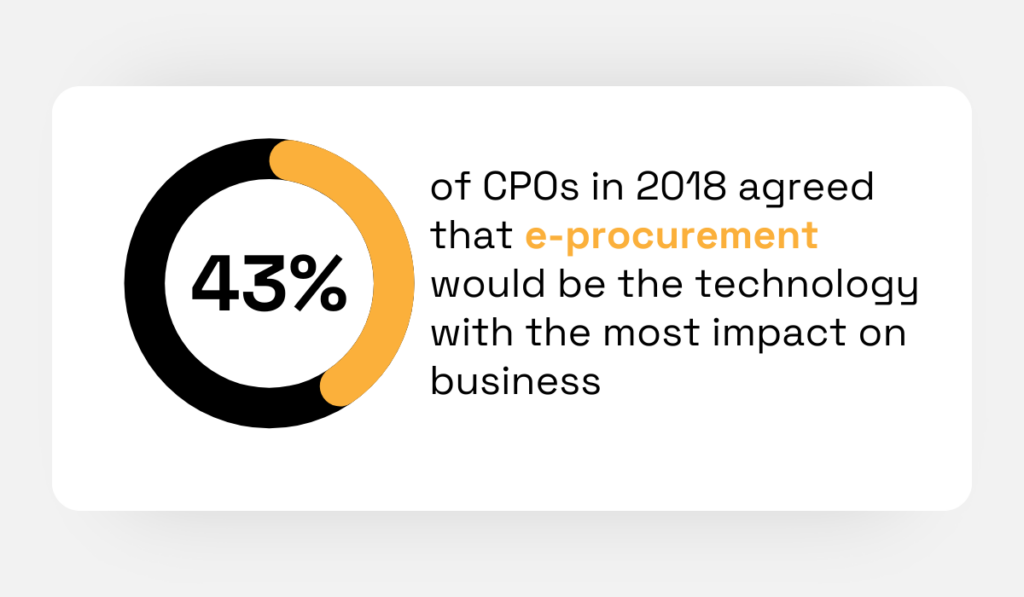
Illustration: Veridion / Data: Deloitte
Although the digitization of procurement processes back then wasn’t where it is today, it’s clear that leaders realized six years ago that automation and moving procurement online could benefit not only procurement teams but entire companies.
And it seems like they were onto something.
Fast forward to today, and the digital transformation in procurement is undeniable.
For example, 2022 research from Amazon Business shows that a whopping 91% of B2B buyers now prefer purchasing online.
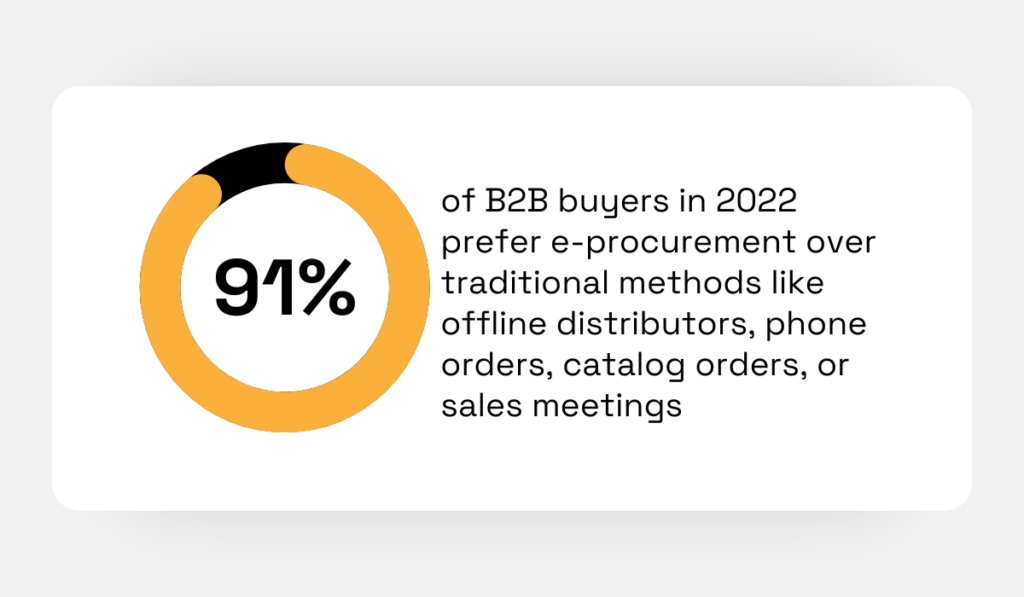
Illustration: Veridion / Data: Amazon Business
The bottom line?
E-procurement has long been seen as a game-changer for businesses, and for good reason, too.
It streamlines the purchasing process, automates workflows, boosts transparency, and enables better supplier management, reducing costs and improving efficiency across the board.
In 2019, Levvel Research, a research and advisory firm, conducted a survey on behalf of Coupa, an AI-driven spend management platform, to explore the state of e-procurement software adoption across companies of various sizes and industries.
Among its many interesting insights, one notable finding was that 1 in 4 lower middle market businesses planned to adopt e-procurement technology within a year.
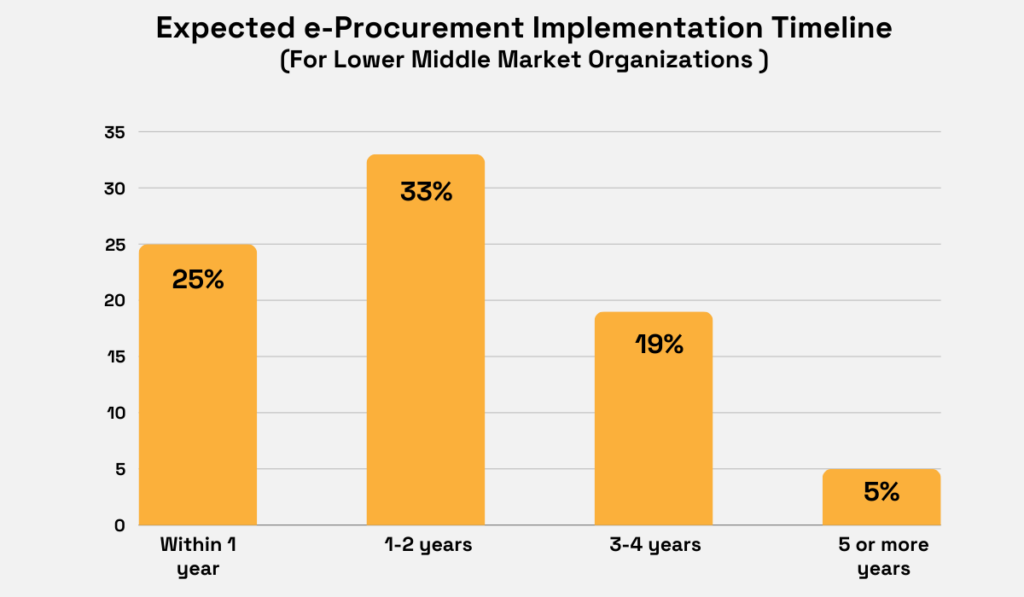
Illustration: Veridion / Data: Coupa
Yet, for others within this bracket, the implementation timelines were longer, ranging from one to two years or three to four years.
This shows a strong interest in e-procurement technology, albeit with businesses being at different stages of readiness or capability to implement such systems.
But what’s causing the delay?
Considering the evident advantages of e-procurement, why aren’t the remaining 75% in a hurry to adopt the tech?
The research sheds light on this as well.
As it turns out, the top three barriers to adopting e-procurement platforms for lower middle market companies are:
However, it’s still clear from the survey that, despite these obstacles, there’s a firm commitment among companies to improve their procurement processes, no matter how long it takes.
In other words, while some may achieve this goal sooner and some later, it seems like all recognize e-procurement as the key to advancing their businesses in the long run.
Another interesting finding from the Coupa and Levvel Research survey is that a little over half of the surveyed enterprises place their orders using e-procurement platforms.
Now, it’s important to note that the research categorizes companies into four segments: enterprises, upper middle market businesses, lower middle market businesses, and SMEs (small and medium-sized enterprises).
And, according to the survey, enterprises—the largest organizations among the four—demonstrate the highest usage of e-procurement for orders.
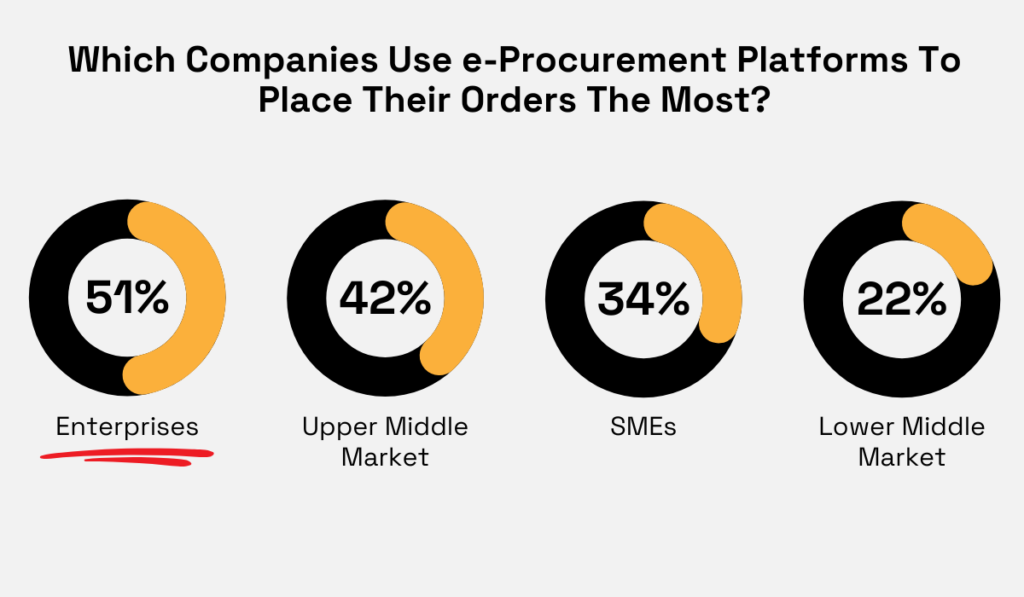
Illustration: Veridion / Data: Coupa
This suggests that as businesses expand, they are more inclined to adopt advanced procurement technology.
After all, the way organizations place orders can significantly impact entire procurement operations.
Therefore, larger companies, engaging in more purchases overall, cannot afford the inefficiencies of manual processes.
Besides, the stakes are much higher for them.
They face more risks and legal consequences when dealing with unreliable suppliers, so using dependable procurement solutions that give them greater control over the ordering process simply makes more sense.
It ensures smooth operations, mitigates potential risks, and empowers procurement teams to make the most cost-effective decisions.
Enterprises also typically have larger budgets at their disposal, which enables them to invest in dedicated e-procurement solutions.
In fact, according to the same Coupa survey, they exhibit the highest adoption rates of cloud-based e-procurement software, while other business types lean towards accounting systems or ERPs with a procurement module.
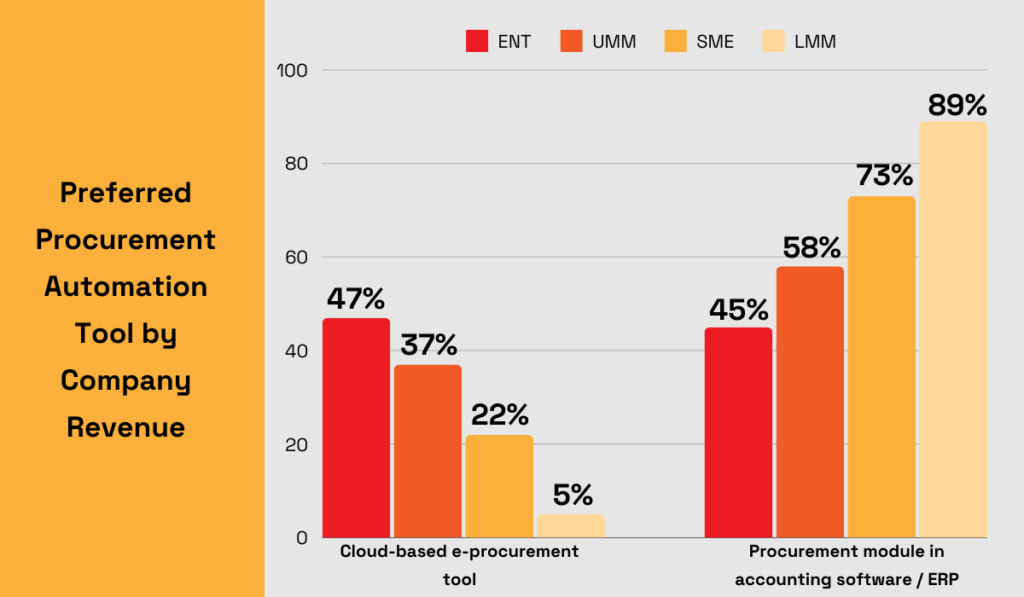
Illustration: Veridion / Data: Coupa
In other words, smaller organizations tend to opt for tools already integrated into their existing software, even if these lack certain critical features of a dedicated e-procurement platform.
Why?
Because, unlike large enterprises, they often don’t have the time or money required to adopt such specialized systems.
Nevertheless, this statistic shows that, as a business grows, transitioning to a dedicated e-procurement platform becomes a must to uphold the efficiency of its operations.
Unlike procurement modules within ERPs—which are often limited in functionality—these specialized solutions are purpose-built for procurement.
Simply put, they offer a wider array of features tailored to various activities such as supplier or contract management, and e-auctions.
As such, they align much better with the complex needs of large companies.
Roman Belotserkovskiy, Partner at McKinsey & Company, agrees that an ERP can take you only so far:
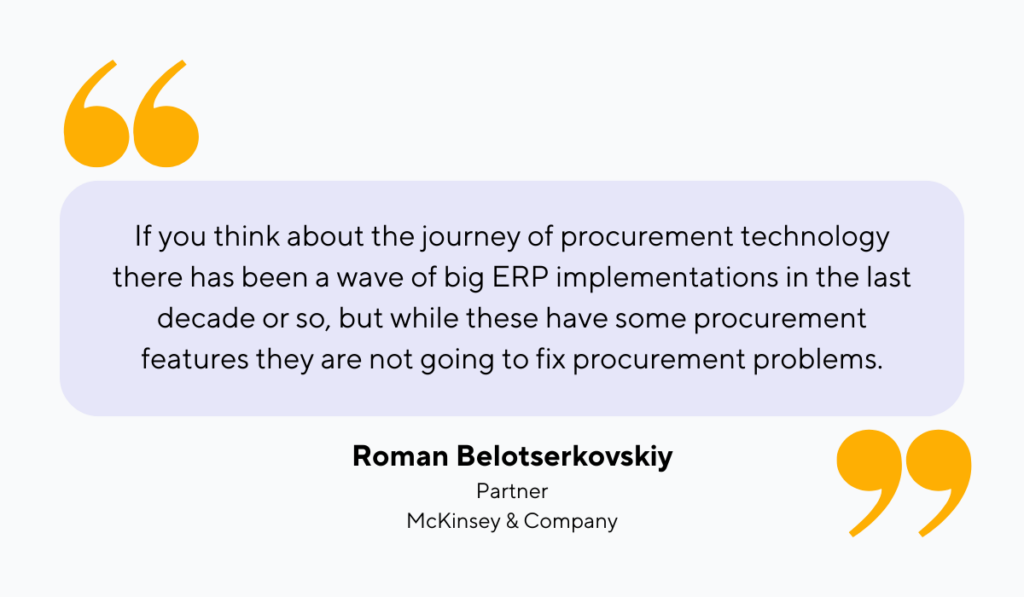
Illustration: Veridion / Quote: Procurement Magazine
Sure, ERPs and accounting systems may seem like cost-effective options at first, but they just aren’t able to tackle all procurement procedures, activities, and tasks.
And for those with substantial procurement requirements, that simply doesn’t cut it.
Procurement offers a very long list of advantages, and reducing paper usage seems to be one of the most prominent ones.
According to a survey conducted by Levvel Research and Coupa, over half of the organizations agreed that the decrease in paper volume was the most significant improvement following the implementation of e-procurement technology.
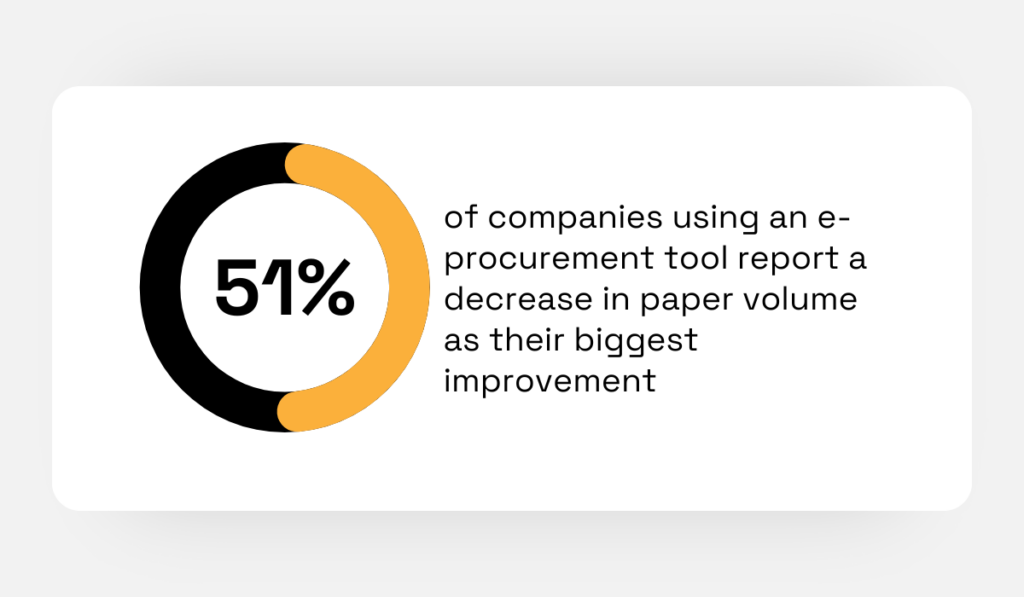
Illustration: Veridion / Data: Coupa
And no, this isn’t just about saving storage space or cutting costs on paper, ink, and manual labor.
For starters, transitioning to a paperless system directly translates to increased efficiency.
E-procurement software stores all documentation in a centralized database, which makes information access, retrieval, sharing, and analysis much simpler.
Essentially, data can be accessed by anyone who needs it, anytime, anywhere, and from any device with an Internet connection.
No more running around the office, desperately trying to find that contract or purchase order.
Secondly, eliminating paper and going digital reduces the risk of information loss.
After all, e-procurement solutions never misfile, damage, misplace, or allow documents to degrade over time.
As a result, you get accurate, up-to-date, and detailed insights into your purchasing processes.
Lastly, with more efficiency and less data loss comes greater transparency in the procurement process, which is particularly beneficial during compliance audits.
Kiran Menghani, Director at Tipico Services Ltd, a part of the iGaming and sports betting brand Tipico Group, can attest to this.
In heavily regulated industries like theirs, every department must be able to provide relevant documentation to auditors at a moment’s notice.
However, Menghani explains, this is where they ran into trouble prior to digitizing their procurement process.
Why?
Precisely because their procurement data was so scattered and hard to retrieve:
“There are always particular questions auditors ask, and to be in a position where we couldn’t answer, or couldn’t find the answer, was not an option. I didn’t want to be running around looking for answers, it should be readily available… but wasn’t.”
Once they got that under control by eliminating paper and introducing procurement software as a single source of truth, demonstrating compliance became a breeze.
So there you have it.
Reducing paper volume isn’t just about saving a few extra dollars on office supplies.
It’s the foundation for more transparent, efficient, compliant, agile, and data-driven operations.
We’ve briefly touched upon the primary reason why lower middle market businesses hesitate to adopt e-procurement: they believe their current methods are good enough.
However, this sentiment isn’t exclusive to them.
It extends to all organization types surveyed by Levvel Research and Coupa.
In fact, 30% of these companies consider the effectiveness of their existing processes sufficient justification for not implementing e-procurement tools.
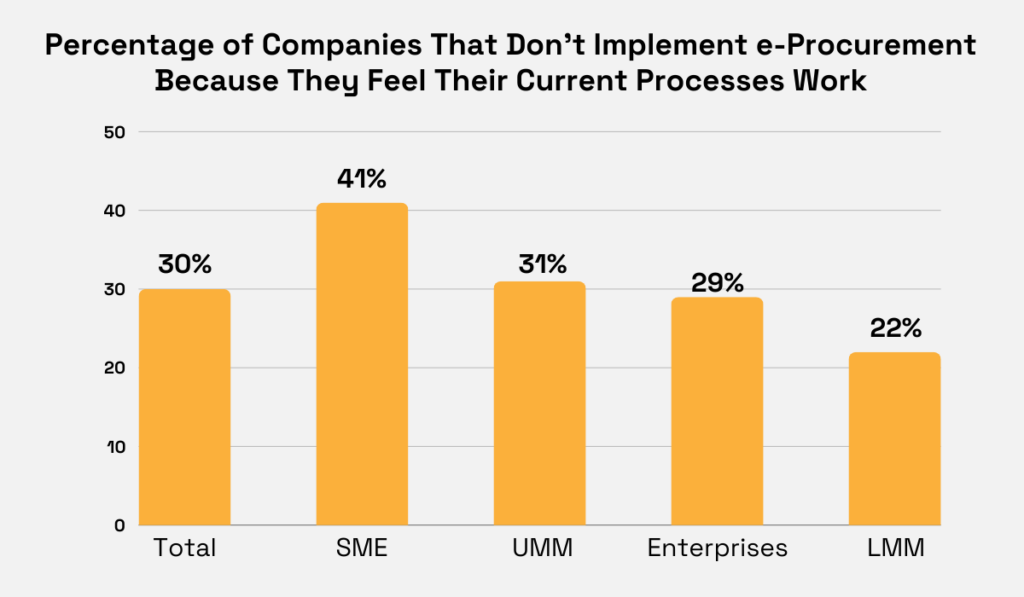
Illustration: Veridion / Data: Coupa
Still, if we take a closer look at the survey results, we see that enterprises report this implementation barrier the least.
This might suggest that the larger the company, the less prevalent this rationale becomes.
It makes sense, really.
As purchasing volumes increase, the inefficiencies of manual procurement processes become more apparent.
Ian Nethercot, Supply Chain Director at the IT procurement company Probrand, elaborates on what these inefficiencies are:
“Standing still on digitalisation will undoubtedly leave businesses at a competitive disadvantage. Bogged down by unnecessary admin, a lack of access to live data is leaving buyers struggling to buy at the best times and gain value from every purchase. As a result, they also have less time to spend building strategic relationships with the suppliers that can help them better meet the needs of their organisation.”
So, even if you feel like you’re doing just fine without an e-procurement solution, take the time to periodically conduct procurement audits and evaluate the effectiveness of your processes.
Ask yourself: is there a particular procedure that’s slowing you down?
Could it, perhaps, be fully automated?
And how much time do you and your team actually waste on low-level tasks?
It just might give you a whole perspective on how you run things.
The 2024 survey from The Hackett Group, titled the CPO Agenda, suggests that procurement professionals are slowly but surely embracing AI technology and becoming aware of its value.
Specifically, the survey indicates that 27% of companies recognize e-procurement as a considerable opportunity area for leveraging generative AI.
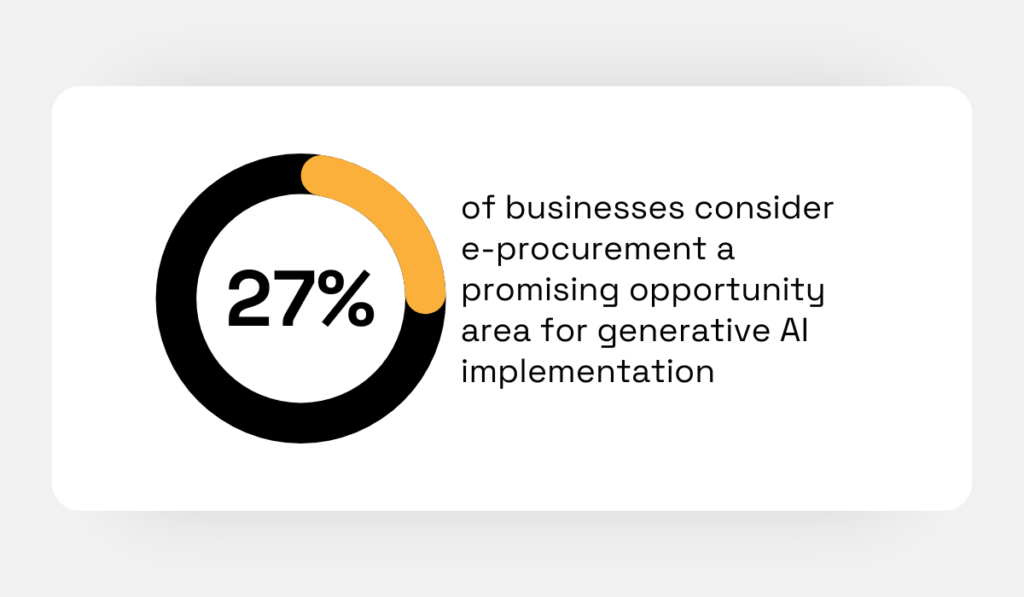
Illustration: Veridion / Data: The Hackett Group
This type of artificial intelligence technology operates by assimilating patterns and structures from extensive datasets and then using that knowledge to produce new content.
When integrated into e-procurement systems, it can fulfill various functions, including intelligent RFP/RFQ creation, automated contract generation, spend analysis, and so much more.
Etosha Thurman, Chief Marketing and Solutions Officer for the software company SAP, gives us a specific example of this technology’s application within procurement.
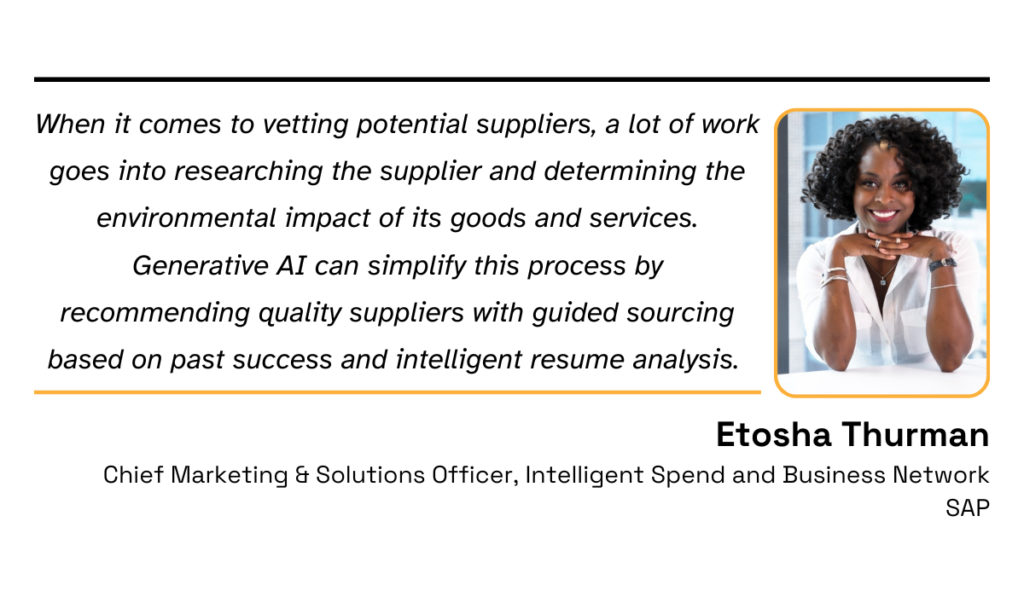
Illustration: Veridion / Quote: Supply Chain Management Review
That’s right:From managing documentation to sourcing suppliers, e-procurement in tandem with generative AI can significantly improve various procurement activities, yielding benefits such as increased efficiency, reduced procurement costs, and improved decision-making.
Sure, 27% may seem relatively modest considering the many advantages and applications of GenAI.
However, this could be primarily attributed to the fact that this technology is still in its early stages, with many procurement professionals yet to fully explore and understand its potential.
It’ll certainly be interesting to see how these trends will evolve in the years ahead.
Overall, all research seems to point in a single direction: e-procurement platforms are both the present and the future of procurement.
And guess what?
Many organizations have already realized this and are reaping all the benefits of this technology.
Therefore, if you want to stay competitive, now is the time to fully explore e-procurement.
Remember, this isn’t about following the latest trend, but about keeping your procurement processes streamlined, efficient, and beneficial for the entire company.